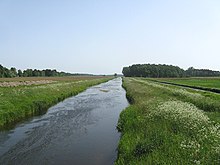Sand and clay shaped lowland river


The sand- and clay-shaped lowland river (type 15) is one of the flowing water types that have been defined by the Federal / State Working Group on Water (LAWA). It was selected as the water type of the year 2012.
Water structure
Sand and clay-shaped lowland rivers flow in a hollow or a wide valley . Their course is usually winding to meandering, impact and sliding slopes are often well developed despite the prevailing calm current. In addition to the predominant sand or clay, the bottom often also consists of relatively large parts of gravel, dead wood and fallen leaves. Sand-shaped waters have a rather shallow, clay-shaped water body a more box-shaped cross profile. Backwaters and tributaries are mostly only present in sand-shaped rivers.
The catchment area of the waters is larger than 100 km².
Flora and fauna
The invertebrates are represented in this type of water with relatively many ways. Examples are the painter's mussel , which Blunt mud snail , various mayflies and caddis fly larvae and dragonflies , as the congregation Clubtail . The fish are represented in the sand-shaped waters by hazel and chub , among other things , in the clay-shaped rivers only a few species of fish are found.
The occurrence of different plant species from the society of the common hedgehog together with various spawn plants is characteristic of the sand-shaped lowland rivers. Various types of water stars can also be found in rivers with more clay deposits . Within the young moraines , the aquatic plants differ greatly in small areas.
Examples
swell
- Profile of the river type 15 on wasserblick.net (PDF file; 177 kB)